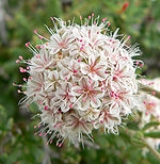
Eriogonum fasciculatum
Encyclopedia
Eriogonum fasciculatum is a species of wild buckwheat
known by the common names California buckwheat and Eastern Mojave buckwheat. This common shrub
is native to the southwestern United States and northwestern Mexico, where it grows on scrubby slopes and in chaparral
and dry washes
in a number of habitats.
There are a number of distinct varieties. It is variable in appearance, forming a patchy, compact bramble or a spreading bush approaching two meters in height and three across. The leaves grow in clusters at nodes along the branches and are leathery, woolly on the undersides, and rolled under along the edges. Flowers appear in dense, frilly clusters which may be anywhere from a few millimeters to 15 centimeters wide. Each individual flower is pink and white and only a few millimeters across. Many Native American groups utilized parts of this plant for a number of medicinal uses, including the treatment of headache
, diarrhea
, and wound
s. This variety is particularly attractive to honey bees (Apis mellifera) and is a good source of nectar over many months in dryer areas.
Eriogonum
Eriogonum is the scientific name for a genus of flowering plants, in the family Polygonaceae. The genus is found in North America and is known as wild buckwheat. This is a highly species-rich genus, and indications are that active speciation is continuing...
known by the common names California buckwheat and Eastern Mojave buckwheat. This common shrub
Shrub
A shrub or bush is distinguished from a tree by its multiple stems and shorter height, usually under 5–6 m tall. A large number of plants may become either shrubs or trees, depending on the growing conditions they experience...
is native to the southwestern United States and northwestern Mexico, where it grows on scrubby slopes and in chaparral
Chaparral
Chaparral is a shrubland or heathland plant community found primarily in the U.S. state of California and in the northern portion of the Baja California peninsula, Mexico...
and dry washes
Arroyo (creek)
An arroyo , a Spanish word translated as brook, and also called a wash is usually a dry creek or stream bed—gulch that temporarily or seasonally fills and flows after sufficient rain. Wadi is a similar term in Africa. In Spain, a rambla has a similar meaning to arroyo.-Types and processes:Arroyos...
in a number of habitats.
There are a number of distinct varieties. It is variable in appearance, forming a patchy, compact bramble or a spreading bush approaching two meters in height and three across. The leaves grow in clusters at nodes along the branches and are leathery, woolly on the undersides, and rolled under along the edges. Flowers appear in dense, frilly clusters which may be anywhere from a few millimeters to 15 centimeters wide. Each individual flower is pink and white and only a few millimeters across. Many Native American groups utilized parts of this plant for a number of medicinal uses, including the treatment of headache
Headache
A headache or cephalalgia is pain anywhere in the region of the head or neck. It can be a symptom of a number of different conditions of the head and neck. The brain tissue itself is not sensitive to pain because it lacks pain receptors. Rather, the pain is caused by disturbance of the...
, diarrhea
Diarrhea
Diarrhea , also spelled diarrhoea, is the condition of having three or more loose or liquid bowel movements per day. It is a common cause of death in developing countries and the second most common cause of infant deaths worldwide. The loss of fluids through diarrhea can cause dehydration and...
, and wound
Wound
A wound is a type of injury in which skin is torn, cut or punctured , or where blunt force trauma causes a contusion . In pathology, it specifically refers to a sharp injury which damages the dermis of the skin.-Open:...
s. This variety is particularly attractive to honey bees (Apis mellifera) and is a good source of nectar over many months in dryer areas.

